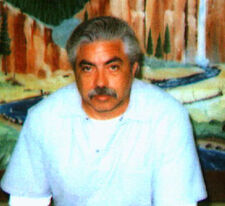
Polly Klaas
Real name: Polly Hannah Klaas
Nicknames: No known nicknames
Location: Petaluma, California
Date: October 1, 1993
Bio[]
Occupation: Student
Date of Birth: January 3, 1981
Height: 4'10"
Weight: 80 lbs.
Marital Status: Single
Characteristics: White female with shoulder-length brown hair and brown eyes. She was wearing a flannel nightgown.
Case[]
Details: Twelve-year-old Polly Klaas lived with her mother, Eve Nichols, and younger sister, Annie, in Petaluma, California, forty miles north of San Francisco. She loved acting in plays and dreamed of acting professionally someday. On the night of Friday, October 1, 1993, she had two of her friends over for a slumber party.
At around 10:30pm, while Polly and her friends were playing a board game, an unidentified man entered the house through an unlocked door or window. He took a knife from the kitchen and entered Polly’s room. He told her and her friends that he only wanted money and did not want to hurt them. He ordered them to lie on the floor and not make a sound, or else he would slit their throats. He tied them up, gagged them, and placed pillowcases over their heads.
The man asked the girls which one of them lived in the house. When Polly answered, he demanded to know where the valuables were. She pointed out some coins and jewelry. He told her friends to count to 1,000. He then left the house with her.
After about twenty minutes, Polly’s friends were able to free themselves. They woke Eve up and told her what had happened. They then called 911. An extensive search for Polly began. Thousands of volunteers came out to help. The Internet was used to help spread Polly’s picture across the country. Polly’s father, Marc, appealed to President Bill Clinton and a statewide television audience for help.
The police questioned Polly’s friends and used a catalog of facial features to create a sketch of the abductor. However, it produced few leads. Two weeks after the abduction, famed sketch artist Jeanne Boylan was called in to help with the case. She believes that showing witnesses catalogs of facial features and interviewing them together can negatively affect their memories.
Jeanne interviewed Polly’s friends separately in their homes without relatives present. She felt that that environment would put less pressure on them. The previous sketch artist had drawn a headband on the suspect and listed his height as 6’3”. After interviewing Polly’s friends, Jeanne found that both of those attributes were incorrect. She created a new sketch of the abductor. Thousands of copies of the sketch were distributed by the police.

Sketch of Polly's abductor
Suspects: The unidentified man responsible for Polly’s abduction was described as being between 5’10” and 6’3” and between the ages of thirty and forty. He had coarse, wavy, salt-and-pepper hair, deep-set eyes, wrinkles, a mustache, and a beard. He smelled of alcohol. He is believed to be a stranger.
Marc was ruled out as a suspect in Polly’s abduction.
Extra Notes:
- This case first aired on the October 2, 1994 episode. It was already solved when it aired; it was used as an example of Jeanne's suspect drawing abilities.
- It was also documented on America’s Most Wanted, American Justice, The FBI Files and Motives & Murders: Cracking the Case.
- It was one of the first missing child cases to be publicized on the Internet.
- It made national news when actress Winona Ryder, who grew up in Petaluma, offered a $200,000 reward for Polly’s safe return. After Davis' conviction, Ryder starred in a film version of Little Women, which had been Polly's favorite book, and dedicated it to her. She also handed over all of her profits from the movie to missing child charities and Polly’s family.
- It led to support for the “three strikes law”, which requires a sentence of twenty-five years to life for any felon with a record of two serious or violent felonies.
- Marc has become an advocate for child safety and established the Polly Klaas Foundation, which helps support families of missing children.

Richard Allen Davis
Results: Solved - About two months after Polly’s abduction, on November 28, 1993, a woman inspecting her property in rural Santa Rosa, twenty miles north of Petaluma, discovered some suspicious items that she believed were related to the case. She immediately contacted the police. The items included a sweatshirt and a torn pair of ballet leggings. The FBI Crime Laboratory later matched them to torn leggings found in Polly’s home.
Investigators reviewed calls in the area on the day of Polly’s abduction. They discovered that about an hour after the abduction, the woman who owned the property had called 911 to report a suspicious vehicle stuck in a ditch next to her private driveway. The family’s babysitter discovered the vehicle while leaving the property.
Two Sonoma County sheriff’s deputies were dispatched to the scene. They were unaware of Polly’s abduction at the time. The owner of the vehicle was identified as thirty-nine-year-old Richard Allen Davis. The deputies checked his driver’s license and license plate number. However, nothing suspicious was found. They helped him get his vehicle out of the ditch and told him to leave the property, which he did.
After learning about the call, investigators looked into Davis as a possible suspect. They realized that he closely resembled Jeanne’s composite sketch. A palm print found in Polly’s bedroom was compared to his palm print; it was a match.
On November 30, Davis was arrested on a parole violation. He had an extensive criminal record that went back thirty years, with previous convictions for burglary, kidnapping, and assaulting women. He had been on parole for just three months at the time of Polly’s abduction. The police conducted an extensive search around Santa Rosa and Davis’ property. However, they found no trace of her.
On December 4, Davis confessed to Polly’s abduction and murder. He claimed that he had been drinking beer and was high on marijuana and PCP when he broke into her house. He said he had “no idea” why he took her. He also said that when his car got stuck in the ditch in Santa Rosa, he left her in the nearby woods, still alive. About thirty minutes later, he returned, picked her up, drove her to another location, and strangled her with a piece of yellow cloth. He said that he killed her because he did not want to go back to prison for abducting her.
After his confession, Davis told the police where he left Polly’s body. Later that day, her remains were recovered in a shallow grave just off Highway 101, near an abandoned lumber mill in Cloverdale, California, thirty-five miles north of Petaluma. Although the medical examiner could not confirm that she was strangled, pieces of cloth and rope were found in her hair.
In May 1994, Davis was charged with Polly’s murder and several “special circumstance” counts, including kidnapping, robbery, burglary, and attempting to commit a lewd act on a child. At his trial, prosecutors theorized that he had been stalking Polly for weeks. Women who had previously been assaulted by him testified. His defense claimed that he only went to Polly’s house to burglarize it. On June 18, 1996, he was convicted on all charges. After the verdict was read, he gave the “middle finger” to the jurors and to a television camera that was broadcasting the court proceedings.
On September 27, Davis was sentenced to death. During sentencing, he claimed that Polly’s father, Marc, had molested her. Marc shouted and lunged at him before being restrained. Prosecutors said there was no evidence to support Davis’ claims. In June 2009, his death sentence was upheld. He remains on death row.
Links:
- Polly Klaas on Wikipedia
- Polly Klaas Foundation Website
- All-Out Search for Missing Girl - October 6, 1993
- Kidnapping of 12-year-old girl shatters calm of California town - October 8, 1993
- Actress Offers Reward to Find Kidnaped Girl - October 10, 1993
- Volunteers Search 2-County Area for Polly Klaas - October 24, 1993
- Suspect's Tip Leads to Body of Polly Klaas - December 5, 1993
- Artist’s Sketch Helps to Capture Kidnapper - December 9, 1993
- Officer Details Suspect’s Confession in Klaas Case - May 13, 1994
- Suspect Charged in Killing of Polly Klaas - June 1, 1994
- Graphic Testimony in Klaas Trial Forces Family Out of Court - May 7, 1996
- Davis Convicted of Murdering Polly Klaas - June 19, 1996
- Polly's Smiling Killer Gets Death Sentence - August 6, 1996
- Before Being Sentenced to Die, Killer Disrupts a Courtroom - September 27, 1996
- Death sentence upheld for Polly Klaas' killer - June 2, 2009
- Forensic Art: The Facial Identification Specialist
- Polly Klaas on Find a Grave
